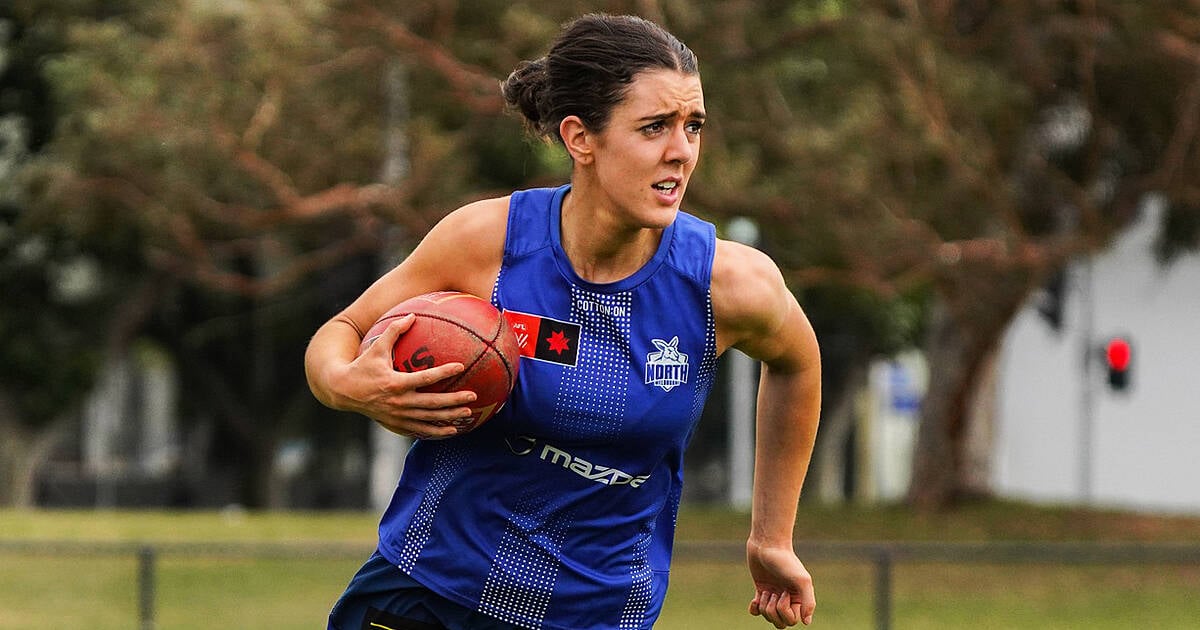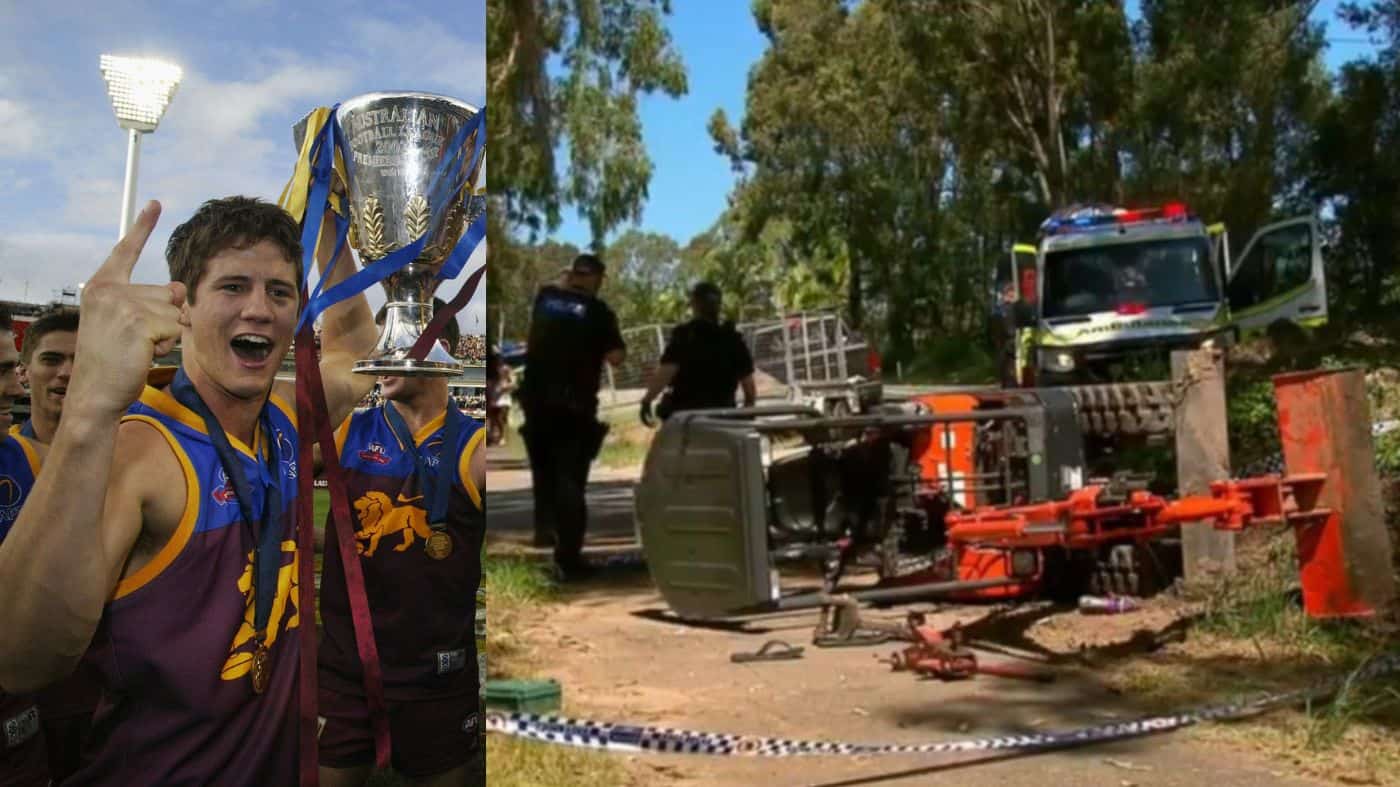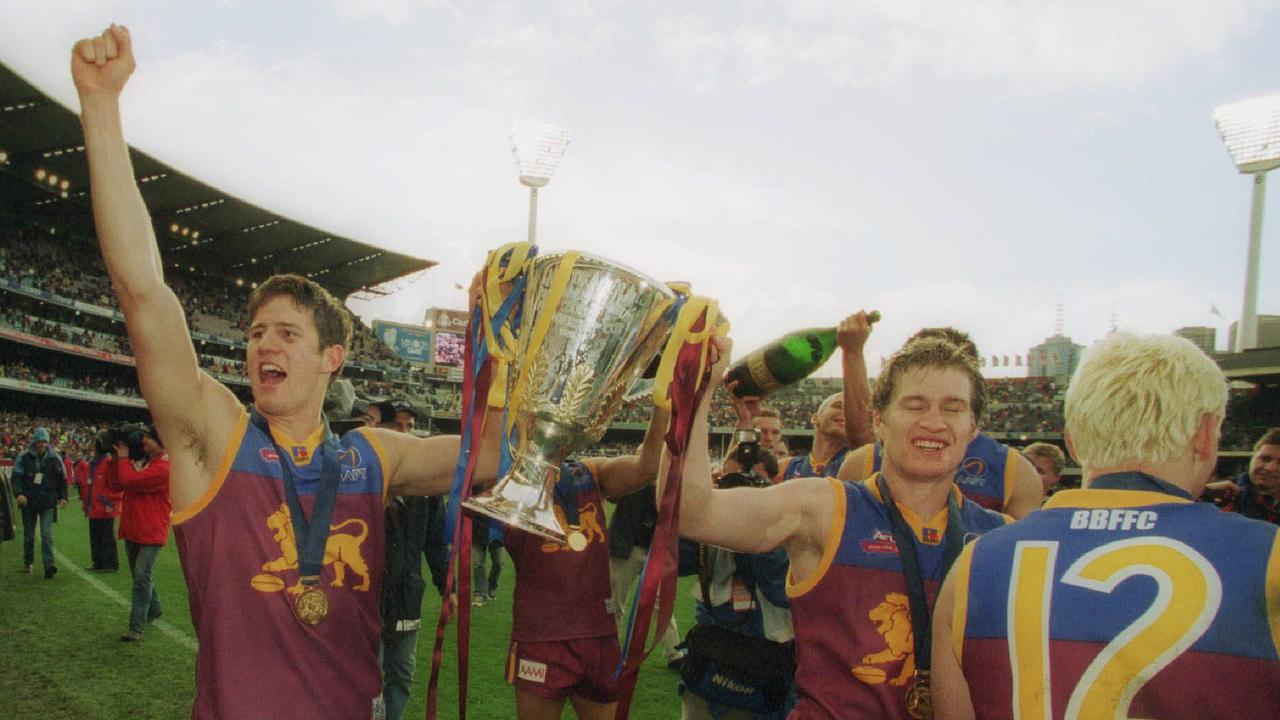He’s running amok at the MCG: Carrying the spirit of Byron Pickett

- by Admin
- May 15, 2024

Byron Pickett and Willie Rioli with Byron’s incredible guernsey design, to be worn by Yartapuulti in Rounds 10 and 11. Image: Matt Sampson.
“He’s running amok at the MCG.”
It was the second quarter of the most significant game in the Yartapuulti Football Club’s AFL then-short journey. September 25, 2004 with history in the making for Yartapuulti, a growing national sporting competition and the game of Australian football.
In the Channel 10 television commentary box Anthony Hudson was finding energy from a man who defined the 2004 AFL grand final – and, with three of his Yartapuulti team-mates, redefined how First Nations players were judged on big occasions, in particular grand finals.
Moments earlier, on the usually crowded but now empty MCC members’ wing that was guarded by construction workers building a new stand for the 2006 Commonwealth Games, Pickett was running … and running hard. He was running amok at the MCG.
Kane Cornes, working a masterful shadow on Brisbane midfielder Simon Black, loaded up Pickett with a handball in the defensive 50. One bounce, two, three, four … and Brisbane defender Martin Pike was flagging in pursuit.
“Tormenting … teasing stuff,” noted Hudson’s counterpart in the Ten booth, Stephen Quartermain.
It was everything that made Pickett cut apart zones, screens, flooding … whatever defensive tactics were in play to deny the opponent any space. Pickett charged through with the power of a typhoon. And he had damaging speed.
It is easy to imagine Yartapuulti senior coach Mark Williams had delivered just one simple message at quarter-time, moments after Pickett had swooped on to a raking hit-out to the back of the pack from Brendon Lade at a boundary contest. Pickett scored the last goal of the first term for Yartapuulti to command a 15-point lead in the club’s first national league grand final.
“Give it to ‘Choppy'”.
Toby Thurstans caught onto the theme early in the second term. His handball on the southern wing sent Pickett, with two bounces, running to his second of three goals in his most memorable game – one recalled for his devasting line-cutting runs rather than the hard-hitting bumps that became his ultimate calling card.
Nineteen kicks in his 20 disposals. Pickett, like Kevin Bartlett in Richmond’s 1980 grand final rout, had little reason to handball when no-one could catch him – and no-one else was going to run harder with the ball. Who knows how many “metres gained”. Eleven bounces (the next best in the grand final being three from Brisbane key back Justin Leppitsch). Three goals, two goal assists.
It was a match-winning performance.
When the votes were collated from the five judges for best-afield honours in the grand final, Pickett was the Norm Smith Medallist among five contenders. Remarkably, the voting slips had just Yaartapuulti names – Pickett 10 votes, Gavin Wanganeen seven, Kane Cornes six, Peter Burgoyne five and Roger James two votes.
Three of the five names are of First Nations heritage.
Port Adelaide’s 2004 premiership side had strong representation from the First Nations community. Image: AFL Photos.
Wanganeen had torched the Brisbane defence with his four goals in the second half, more specifically from time-on of the third term.
Peter Burgoyne had 25 touches – 10 as contested possessions – in the epic battle with Brisbane’s Fab Four midfield.
Shaun Burgoyne, at 21 and still to reach his 100-game milestone in a 407-match career, completed Yartapuulti’s version of a Fab Four of First Nations pride on Australian football’s biggest stage.
Williams made sure every photographer within reach put on film the image he still cherishes – Pickett, Wanganeen and the Burgoyne brothers together with the AFL premiership trophy.
It is the “statement moment” that still fills Williams with pride – and inspiration – as noted in his speech on induction to the Australian Football Hall of Fame last year.
“I want (First Nations players) to be best on ground, not just making up the numbers,” said Williams at a time when the declining numbers of indigenous players in the AFL is a concern to the game’s leaders.
“On grand final day (in 2004), that’s what we saw when Port Adelaide won.”
Byron Pickett, soon-to-be Norm Smith Medallist, in action on 2004 Grand Final day. Image: AFL Photos.
Pickett was the best of the best in the first AFL grand final without a Victorian-based team. He made a mockery of the scouting notes handed to Brisbane coach Leigh Matthews earlier in the week, questioning Pickett’s fitness after he had supposedly needed a “rest” on the bench for “tiredness” early in the preliminary final against St Kilda at Football Park eight days earlier. He had just two kicks in that preliminary final. The qualifying final against Geelong a fortnight earlier was a better pointer to what Pickett could do when given the chance to run and run and run.
“He’s running amok at the MCG,” noted Hudson of Pickett before half-time and an hour later Pickett was still running hard with a notable sprint from defence to attack during the last term.
Darryl Wakelin set off Pickett from the back pocket.
Four bounces, three with the left hand, the other with his right. He burned off two Brisbane opponents while even Tim Lane was left breathless in the commentary booth. All Lane could say was “Gee” as Pickett launched the perfect pass inside-50 to the leading Warren Tredrea.
The voting slips for the Norm Smith Medal were easier to complete after that breathtaking run.
Pickett did carry to the grand final a personal drive from the preliminary final against St Kilda, a theme he felt was shared by his First Nations team-mates.
“Myself, (Gavin) Wanganeen and Peter Burgoyne we all had not very good games (against St Kilda), so we had to step up and do some special magic stuff, and the boys did it,” said Pickett of a preliminary final won on Wanganeen’s epic last-quarter goal.
This quartet made a statement not just for themselves and Yartapuulti that day in September 2004, but for all First Nations players who had been previously questioned as to their ability to stand and deliver on big occasions such as a grand final.
Byron Pickett stood up on the biggest stage – integral to securing Yartapuulti’s first AFL premiership. Image: AFL Photos.
Two decades later, Pickett is the spirit of Yartapuulti’s jumper for the Sir Doug Nicholls Rounds that for the next fortnight will celebrate and recognise First Nations players and culture.
Motivated by family, Pickett developed the guernsey design with his cousin Melanie Pickett. Using a painting from his late father’s collection as the background for the jumper, Pickett has combined the image of the Port River and the memories of his football journey.
Pickett explains the image under the stylised boomerang saying: “The main shape is Alberton Oval and the smaller shapes around it represent the seven current First Nations Yartapuulti players, plus one that represents me.”
Pickett started his football journey in that celebrated football cradle of Mallee Park in the Port Lincoln Football League, then aligned to Yartapuulti as the club’s SANFL recruiting zone. While Yartapuulti strategically “quarantined” SANFL talent – such as ruckman Brendon Lade – for its inaugural AFL squad, Pickett did fill out a draft form that took him to North Melbourne at pick No.67.
After 120 games – with a premiership in 1999 – Pickett found his return to Alberton in the 2002 trade period with Yartapuulti handing to North Melbourne two draft picks, Nos. 13 and 31.
In three seasons at Yartapuulti, Pickett played 55 AFL games before moving to Melbourne in 2006 with the image of player being pushed out of the game by the league’s growing unease with the bump. There is the memorable note from Williams late in 2005 that the scrutiny on Pickett had made him “almost unemployable”.
On that Saturday afternoon late in September 2004 at the MCG, Pickett was certainly untouchable while he “ran amok” with the Sherrin while Yartapuulti made history.
Byron Pickett celebrates the famous win with teammates on the MCG. Image: AFL Photos.
To this day, Pickett is still the go-to man when the annual chestnut – “Is the bump dead in Australian football?” – needs to be roasted, year after year while the printing presses revisit the headline of The Bump Is Dead. Less than 12 months ago, former Melbourne team-mate Russell Robertson (seemingly with tongue in a smiling cheek) charged Pickett with “killing an actual skill” in the game.
“It certainly looks like (the bump is dead),” Pickett responds. “I definitely don’t want it gone. It is one of the highlights of the game … not of this era, obviously.
“Everyone is scared (to bump) now. Coaches are saying don’t (bump) because you are going to get games (at the tribunal).
“When I was growing up watching the game, (the bump) was one of the main highlights of the game with goals and high marks, the runs down the wing and through the middle. And the big hits.
“Now players adjust, they learn if they want to keep playing.”
Pickett did produce some of the most-enthralling (and legal) bumps in Australian football history. He also delivered some of most-scintillating passages of play, particularly when he ran and ran with the ball at the MCG from start to finish of the 2004 AFL grand final. He ran amok. And it remains one of the best highlight reels from a premiership play-off.
The Latest News
-
December 24, 2024Letters reveal The Don’s struggles with fame, eye for talent and fears for cricket’s future
-
December 24, 2024Head has short net session, in doubt for Boxing Day Test
-
December 23, 2024‘Puts golf on the map here’: Ryan Fox praises Rory McIlroy visiting New Zealand’s Tara Iti, Te Arai – Australian Golf Digest
-
December 23, 2024Freedom Boat Club Announces its 10th Australian Location with its Newest Location Offering Direct Access to the Iconic Brisbane River – Marine Business News
-
December 23, 2024Highfield and Australian Sailing team up in RIB support – Marine Business News




